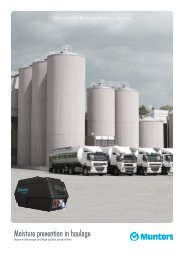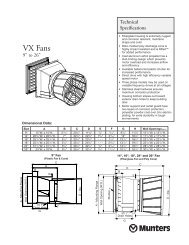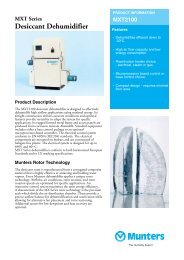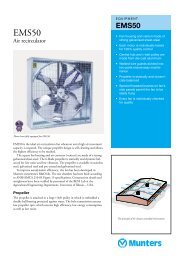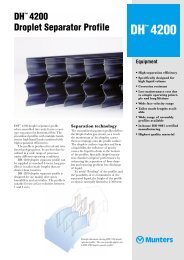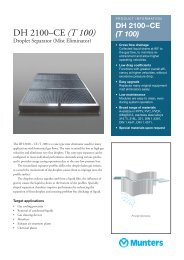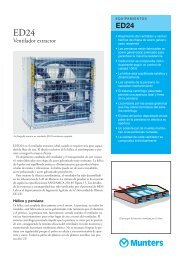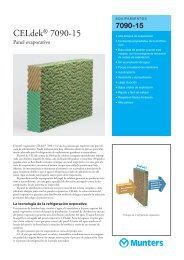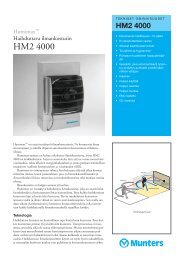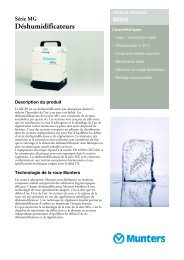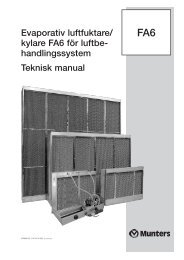Annual Report 2006 - Munters
Annual Report 2006 - Munters
Annual Report 2006 - Munters
Create successful ePaper yourself
Turn your PDF publications into a flip-book with our unique Google optimized e-Paper software.
HumiCool Division– instead of open poultry houses that are still commonplace inAsia and Latin America – to reduce the risk of spreading infections,has resulted in continued good demand for <strong>Munters</strong>’cooling systems.The increased global demand for “clean” coal power had avery strong positive affect on the Mist Elimination businessarea during the year.At HVAC, overall demand was more restrained, althoughthe business area did show growth during the year. Duringthe fourth quarter the Italian firm SIAL was acquired, theEuropean market leader in mobile heaters for industry,agriculture and commercial premises and evaporative coolingproducts. The acquisition strengthens <strong>Munters</strong>’ position sinceSIAL offers complementary offerings for HVAC customers.At the same time, <strong>Munters</strong> gains additional distribution channelsand expertise within the HVAC area.Demand for gas turbine cooling systems at GTECincreased during the year, albeit from a previously low level.For the HumiCool Division as a whole, the recentadjustments and production relocations have contributed tostrong margin growth during the year, especially as a resultof increased global purchasing, improved productivity andgreater coordination in manufacturing and distribution.During the year, all manufacturing of cooling pads in theUS was shifted to an existing facility in Mexico. Sales tothe American market of those components is now occurringthrough a new distribution center in Andrews, NC in the US.The decision was made during the year to double the capacityof the existing plant in Beijing, a facility that is used by boththe HumiCool and Dehumidification Divisions.Efforts to cultivate and focus operations continued duringthe year, and as part of that effort the Water business area,with water treatment operations, was sold during the firstquarter. In January 2007, the DEC (Diesel Emission Control)business area was also sold. Both of these operations experiencedfew synergies with <strong>Munters</strong>’ core operations.StrategyExpand energy-efficient climate control product offerings.Expand geographically, primarily in Asia.Growth through acquisitions.Improve gross margins.Utilize the global organizational structure to achieve costsavings and efficiency gains.Increase product development resources.Focus 2007Work will continue during 2007 in accordance with thewell-defined plan that is aimed at strengthening competitiveness,creating additional growth and increasing profitabilitywithin the division. This plan includes actively seeking outnew acquisitions that will broaden existing product offeringsin the area of energy-efficient climate control, to movetowards more solutions-oriented offerings, and to expand thegeographic area of operations. Expansion of production facilitiesin Beijing is expected to be completed during the thirdquarter of 2007.<strong>Munters</strong> will also continue to focus on measures aimedat strengthening gross margins and benefit from the advantagesthat the global organizational structure provides. Anincreased exchange of knowledge and a high degree of coordinationwithin product development, manufacturing and purchasingwill result in additional savings and efficiency gains.In marketing, customer offerings, products and distributionwill be coordinated and enhanced, yielding positive effects onsales and profitability.CUSTOMER CASEClimate controls yield more Turkish bananasBanana, grapefruit and cherry tree seedlings arecultivated at the Toros Agripark in Turkey, which wasformerly experiencing problems with its greenhouseclimate. The existing cooling system, which was basedon water mist from high-pressure sprinklers, wasinsufficient to achieve the stable environment the plantsthrive in, namely a consistent temperature of between25–28ºC, with a relative humidity of 85 percent. Thebiggest problem was during the summer months whenan outdoor temperature in excess of 40ºC made itpractically impossible to cultivate plants.It took two weeks for <strong>Munters</strong> to install a coolingsystem that has created an optimal greenhouse climateyear round. As a result, production of plants hasincreased by 25 percent. In addition, overall productioncosts have dropped and the ability to manage cultivationduring the most beneficial planting period has increased.28 M U N T E R S A N N U A L R E P O R T 2 0 0 6



